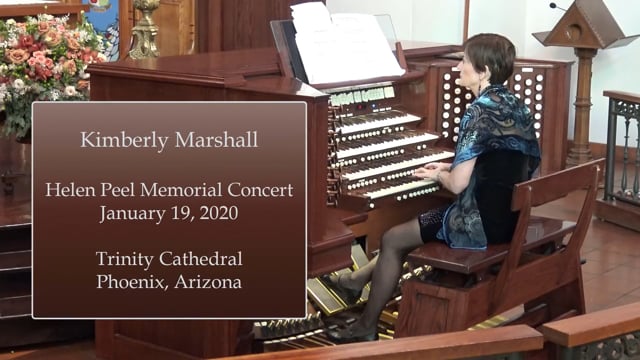
Kimberly Marshall is known worldwide for her compelling programs and presentations of organ music. Her distinguished achievement in organ performance and scholarship was recognized by the Royal College of Organists in 2022 with their highest award. She is an accomplished teacher, giving master classes internationally. She currently holds the Patricia and Leonard Goldman Endowed Professorship in Organ at Arizona State University and the Hedda Andersson Visiting Professorship at the Malmö Academy of Music.
Marshall has performed and presented her research at 11 national conventions of the AGO. A review of her recital in Washington, D.C., in July 2010 praised her as “a multi-faceted musician” who “pushed the organ to its limit with her virtuosic demands in playing and registration….This was a royal performance by one of our royalty!” During the summer of 2013, she appeared in Amsterdam, Seoul and Sweden; in 2014, she was a featured artist on performance series in England, Germany, France, New York and San Diego. A highlight of 2015 was Marshall’s concert on the earliest surviving instrument in the Netherlands, built in 1511. In 2016, she played recitals in Philadelphia, Bolivia, Amsterdam and Vienna, while her engagements in 2017 included the opening recital for the AGO regional convention in Salt Lake City and an inaugural recital of the new Fritts organ for the Basilica at the University of Notre-Dame. In July 2018, she was chosen as the organ soloist with orchestra for the final concert of the AGO national convention in the Kauffman Center, Kansas City, where she was extolled for “the ease and facility” with which she performed the “virtuosic pedal cadenza.” (The American Organist, October 2018).
In 2019, Kimberly Marshall inaugurated the new Klais organ in St. Petri Cathedral, Malmö, the largest instrument in Scandinavia. She appeared at the Boston Early Music Festival and gave the opening concert for the national convention of the Organ Historical Society in Dallas. Her expertise in early Spanish and Italian repertoire was acknowledged by invitations to perform on the Spanish baroque-style organ at Oberlin Conservatory and the Italian-baroque inspired organ at Christ Church Cathedral, Cincinnati. She performed and taught at the Göteborg International Organ Academy in 2020, 2021 and 2022, opening the Malmö Organ Festival in May 2022. In the same month, she gave the first guest concert at Washington National Cathedral since the pandemic, to an enthusiastic audience.
Performer, scholar, and educator, Kimberly Marshall is a committed advocate of the organ. She works to promote the instrument in both local and global communities. She is regularly consulted by churches searching for organists and music directors, as well as by institutions seeking advice on instrument installations. She is the advisor on organs for the Musical Instrument Museum (MIM) in Phoenix and has made videos in Guanajuato (Mexico), Toulouse (France), and Florence (Italy) for their exhibits. An authority on the organ’s rich history over the past 2000 years, she is devoted to continuing this tradition of artistic ingenuity into the next millennium.
See http://www.kimberlymarshall.com/ or visit https://www.facebook.com/KimberlyMarshall.organist.







